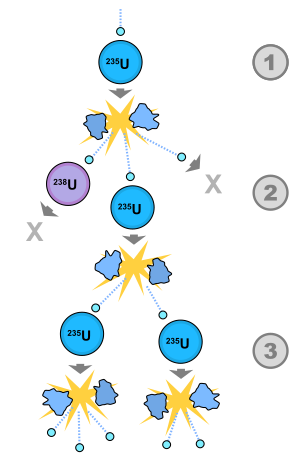The nucleus of any atom is very unstable. It is due to the presence of neutrons in the nucleus that it becomes very unstable. There are other particles other than neutron and proton in the nucleus. One of those are the neutrinos. These are particles which are responsible for the stable form of the nucleus. Neutrinos are affected only by the weak nuclear forces.
Thus due to the unstable form of the nucleus, there are two types of reactions which can take place in the nucleus: Nuclear Fission and Nuclear Fusion.
Nuclear Fission: When a heavy nucleus breaks up into two or more nuclei, the reaction is known as nuclear fission. For example: When a neutron is bombarded with a nucleus of a heavy atom like Uranium 235, the product so formed is Krypton(92) and Barium(141) with the release of three neutrons.
 |
| Nuclear Fission |
Explanation: For atoms with low atomic numbers, a nucleus that has a different number of protons than neutrons can potentially drop to a lower energy state through a radioactive decay that causes the number of protons and neutrons to more closely match. As a result, atoms with roughly matching numbers of protons and neutrons are more stable against decay. However, with increasing atomic number, the mutual repulsion of the protons requires an increasing proportion of neutrons to maintain the stability of the nucleus, which modifies this trend. Thus, there are no stable nuclei with equal proton and neutron numbers above atomic number Z = 20 (calcium); and as Z increases toward the heaviest nuclei, the ratio of neutrons per proton required for stability increases to about 1.5 (1.5 ratio shows instability of the nucleus).
Chain Reaction: Spontaneous fission reactions taking place one after the other is a chain reaction.
Explanation: When a neutron is made to bombard with a heavy nucleus, the two or more(two is often) products are formed with release of three neutrons. These neutrons can further be used to bombard with three more nucleus and there is release of nine neutrons. This process is continuous and can be controlled as well as uncontrolled. Controlled processes are known as controlled fission reactions and Uncontrolled processes are known as uncontrolled fission reactions.
 |
| Fission chain reaction. |
The Controlled fission reactions are used in nuclear reactors where cadmium rods are used to absorb the excess neutrons. Thus out of three neutrons, only one is made to bombard with a nucleus and hence the reaction is controlled.





0 comments:
Post a Comment